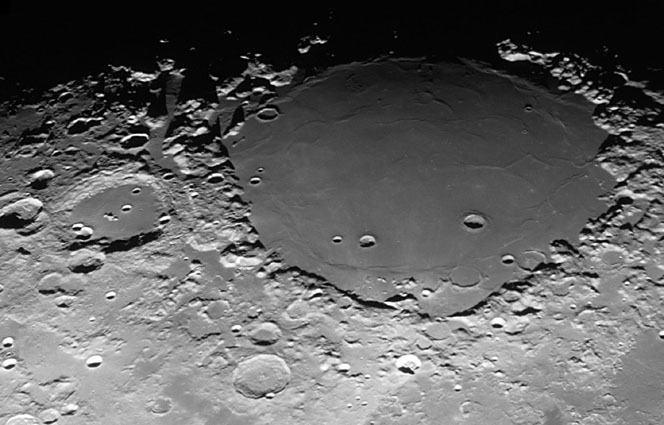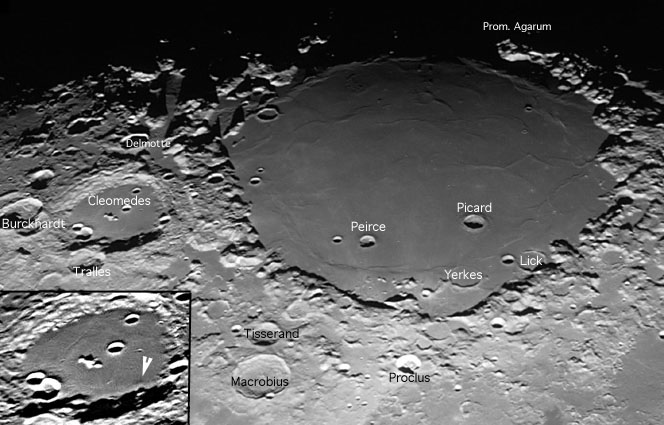Difference between revisions of "September 30, 2004"
| (13 intermediate revisions by the same user not shown) | |||
| Line 1: | Line 1: | ||
__NOTOC__ | __NOTOC__ | ||
=Crisium Closeup= | =Crisium Closeup= | ||
| − | + | <!-- Start of content --> | |
<table width="85%" border="0" align="center" cellpadding="6" cellspacing="2"> | <table width="85%" border="0" align="center" cellpadding="6" cellspacing="2"> | ||
| − | + | <tr> | |
| − | + | <td width="50%"> | |
| − | + | </td> | |
| − | + | </tr> | |
| − | |||
| − | |||
</table> | </table> | ||
<table width="85%" border="0" align="center" cellpadding="6" cellspacing="2"> | <table width="85%" border="0" align="center" cellpadding="6" cellspacing="2"> | ||
| − | + | <tr> | |
| − | + | <td colspan="2" valign="top"><div align="center"> | |
| − | + | <!-- Mouse style 1 --> | |
| − | + | {{HoverImage|LPOD-2004-09-30.jpeg|LPOD-2004-09-30b.jpeg}} | |
| − | + | </div></td> | |
| − | + | </tr> | |
| − | |||
</table> | </table> | ||
<table width="80%" border="0" align="center" cellpadding="8"> | <table width="80%" border="0" align="center" cellpadding="8"> | ||
| − | + | <tr> | |
| − | + | <td><div align="center" class="main_sm"><p>Image Credit: [mailto:stefan.seip@t-online.de Stefan Seip]</p> | |
| − | + | </div></td> | |
| − | + | </tr> | |
</table> | </table> | ||
<br> | <br> | ||
<table class="story" border="0" bgcolor="#FFFFFF" width="90%" cellpadding="10" align="center"><tr><td> | <table class="story" border="0" bgcolor="#FFFFFF" width="90%" cellpadding="10" align="center"><tr><td> | ||
| − | + | <p align="center"><b>Crisium Closeup</b></p> | |
| − | + | <p align="left">One of the most distinctive regions on the Moon is Mare Crisium, which is isolated from all other maria and visible even without binoculars. Mare Crisium, like Mare Humorum, has suffered few subsequent large impacts, and the lava is deep enough that only a few older craters stick through it. Chief among these are Yerkes and Lick, which formed on a shallow bench whose edge is marked by a roughly concentric ring of mare ridges. The basin rim of Crisium is unique in featuring squat mountains, called massifs. Perhaps the Apennines around Imbrium would look similar if the mare flooding was deeper. Just north of Crisium is one of the larger lunar craters that is widely unobserved. Cleomedes (diameter 126 km, depth 4.3 km) is often overlooked because the interesting features on its floor are hard to see. Stefan has taken one of the few images to clearly show the rille and a possible dome (arrowed on mouseover). I have enhanced the contrast and inserted an enlarged Cleomedes into the corner of Stefan's image. Because the Lunar Orbiter IV images of Cleomedes are poor, it is a great target for high resolution imaging!</p> | |
| − | + | <blockquote> | |
| − | <p align="left" | + | <p align="right">— [mailto:tychocrater@yahoo.com Chuck Wood]</p></blockquote> |
| + | <p align="left"><b>Technical Details:</b><br> | ||
Aug 3, 2004, 2:54 UT. Astro-Physics 10" f/14.6 Maksutov-Cassegrain reflector | Aug 3, 2004, 2:54 UT. Astro-Physics 10" f/14.6 Maksutov-Cassegrain reflector | ||
@ f/30 (eff. focal length: 7400mm) + Astro-Physics 2x Barlow + SBIG STL 11000M camera; Exposure Time(s): 0.05 seconds; Dark- and flatframes applied; MaxIm DL, PhotoShop. This is not a mosaic nor a composite, but a single frame. </p> | @ f/30 (eff. focal length: 7400mm) + Astro-Physics 2x Barlow + SBIG STL 11000M camera; Exposure Time(s): 0.05 seconds; Dark- and flatframes applied; MaxIm DL, PhotoShop. This is not a mosaic nor a composite, but a single frame. </p> | ||
| Line 36: | Line 34: | ||
[http://www.lpi.usra.edu/research/lunar_orbiter/bin/info.shtml?572 Lunar Orbiter IV View] | [http://www.lpi.usra.edu/research/lunar_orbiter/bin/info.shtml?572 Lunar Orbiter IV View] | ||
<br> | <br> | ||
| − | [http://www.photomeeting.de/astromeeting/_index.htm Stefan's Astro-images] | + | [http://www.photomeeting.de/astromeeting/_index.htm Stefan's Astro-images] </p> |
| − | <p | + | <p><b>Yesterday's LPOD:</b> [[September 29, 2004|Mountains at the Pole]] </p> |
| − | + | <p><b>Tomorrow's LPOD:</b> [[October 1, 2004|Julius Franz and Mare Orientale]] </p> | |
| − | + | </tr> | |
</table> | </table> | ||
<br> | <br> | ||
<table width="100%" border="0" cellspacing="2" cellpadding="4"> | <table width="100%" border="0" cellspacing="2" cellpadding="4"> | ||
| − | + | <tr> | |
| − | + | <td><hr></td> | |
| − | + | </tr> | |
| − | + | <tr><td> | |
| − | + | <p align="center" class="main_titles"><b>Author & Editor:</b><br> | |
| − | + | [mailto:tychocrater@yahoo.com Charles A. Wood]</p> | |
| − | + | <!-- Cleanup of credits --> | |
| − | + | <!-- Cleanup of credits --> | |
| − | + | <!-- Cleanup of credits --> | |
| − | + | <!-- Cleanup of credits --> | |
| − | + | <!-- Cleanup of credits --> | |
| − | + | <!-- Cleanup of credits --> | |
| − | + | <!-- Cleanup of credits --> | |
| − | + | <!-- Cleanup of credits --> | |
| − | + | <!-- Cleanup of credits --> | |
| − | + | </td></tr> | |
| − | |||
</table> | </table> | ||
| − | + | <!-- End of content --> | |
| − | + | {{wiki/ArticleFooter}} | |
| − | ---- | ||
| − | |||
| − | |||
Latest revision as of 14:57, 15 March 2015
Crisium Closeup
Image Credit: Stefan Seip |
|
Crisium Closeup One of the most distinctive regions on the Moon is Mare Crisium, which is isolated from all other maria and visible even without binoculars. Mare Crisium, like Mare Humorum, has suffered few subsequent large impacts, and the lava is deep enough that only a few older craters stick through it. Chief among these are Yerkes and Lick, which formed on a shallow bench whose edge is marked by a roughly concentric ring of mare ridges. The basin rim of Crisium is unique in featuring squat mountains, called massifs. Perhaps the Apennines around Imbrium would look similar if the mare flooding was deeper. Just north of Crisium is one of the larger lunar craters that is widely unobserved. Cleomedes (diameter 126 km, depth 4.3 km) is often overlooked because the interesting features on its floor are hard to see. Stefan has taken one of the few images to clearly show the rille and a possible dome (arrowed on mouseover). I have enhanced the contrast and inserted an enlarged Cleomedes into the corner of Stefan's image. Because the Lunar Orbiter IV images of Cleomedes are poor, it is a great target for high resolution imaging! Technical Details: Related Links: Yesterday's LPOD: Mountains at the Pole Tomorrow's LPOD: Julius Franz and Mare Orientale |
|
Author & Editor: |
COMMENTS?
Register, Log in, and join in the comments.





